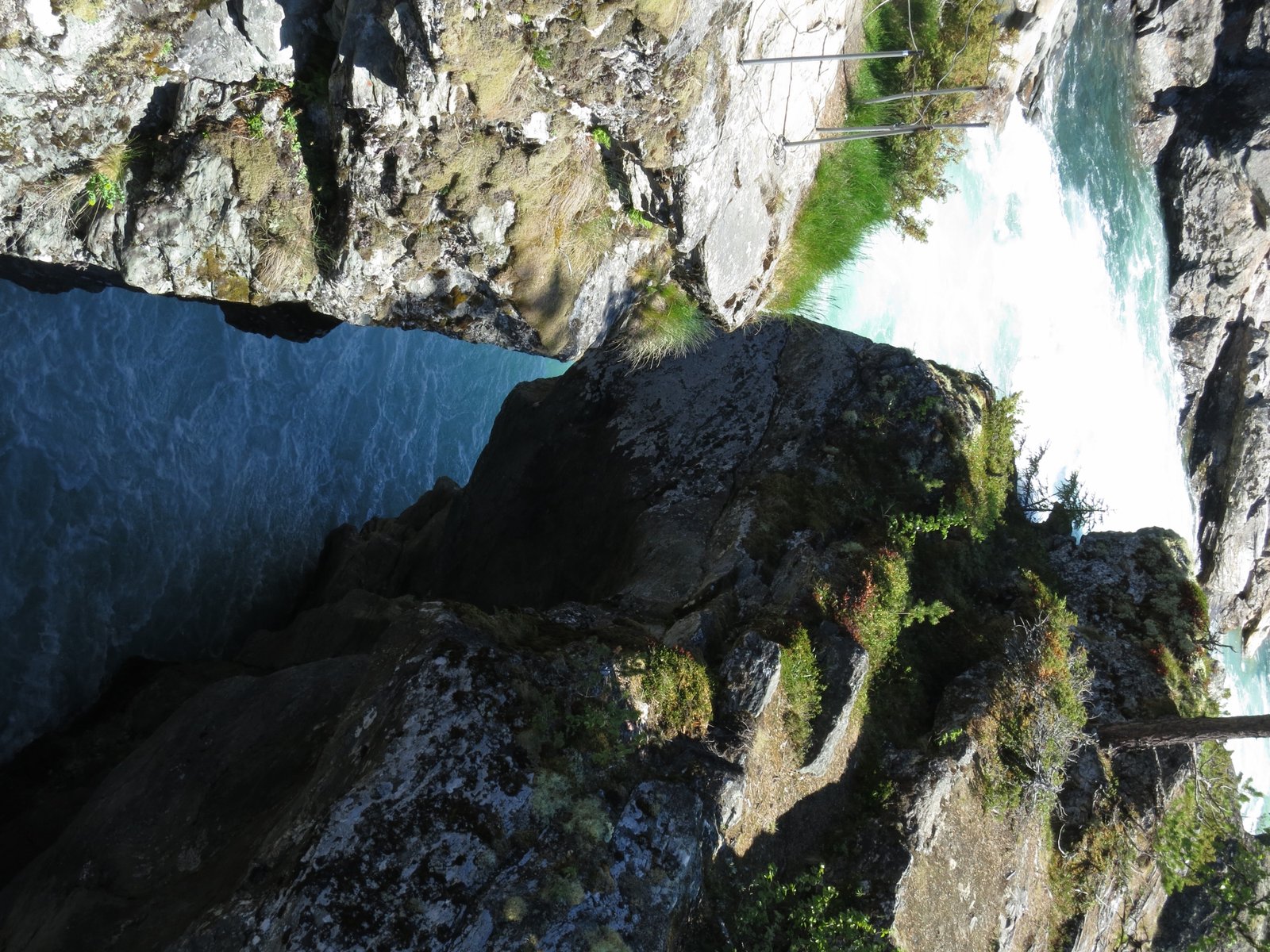Once upon a time, the brave knight Sigvat, advisor to the King, got letter from a beautiful maiden who was forced into engagement with another knight, Eldjarn. Eldjarn means «fire-iron», so we can assume he was The Evil Guy. Sigvat decided to liberate her. He rode to Eldjarns farm and freed the girl. Eldjarn chased him, but had to give in when Sigvat, on horse, maiden in arms, jumped across a narrow gorge in the river Sjoa, where the fierce river ran in the deep canyon beneath.
So the saga says. May be more fairy tale than truth – the names vary – but the place is real: Ridderspranget, “the Knight’s Leap”, is a gorge in the River Sjoa, approximately as mid in south Norway as can be. The mighty gorge has a geological tale to tell. In fact, it has two.
The first tale is about the rock itself. It is soft – at least rock soft – and seems to consist of tiny, tiny layers in fifty shades of grey. Once upon a time, they were layers, of sand and mud in a shallow ocean, on the edge of the continent Baltica, around 600 million years ago. Baltica consisted of today’s Scandinavia, the Baltic, much of Russia east to the Urals, and a big chunk of north Europe.
425 million years ago, Baltica smashed into Avalonia, today’s Greenland and North America, and stacked up slices of rocks into a huge layer cake, a mountain chain may be even bigger than the Himalayas: The Caledonides, which stretched from Svalbard in the north, trough Norway, Scotland (a.k.a. Caledonia) and became the Appalachians in the USA. Our poor sand and shale found themselves in the front of the mountains, they avoided getting buried under the big mountains, but got some heat, some rocks on top and a good squeeze. Sand and shale became metamorphosed to quartzite and schist, and the layers became thin deformation sheets, foliation in geo-speak.
Then the mountains collapsed and 400 million years passed. Norway got stretched, new layers piled on top, only to be scraped off again by the Ice Ages. But the ice also dug out valleys, and here the second tale starts:
In the middle of valleys run rivers… Or, more right: Rivers erode out valleys where ice can get hold, the ice erodes the narrow V-valleys to wide U-valleys…and then, when the Ice Age ended, rivers had a nice, wide valley to play in.
Still soft, rock-wise, the schists were easy prey for river erosion, with a little fracturing help from winter frost. And trolls.
When rivers float across more-or-less even rocks with a steep step down at the end, they will eat themselves backwards and create a gorge. Grand Canyon, slightly larger and more famous, is an example of the same; it formed when the Colorado plateau lifted up and the Colorado river ate itself backwards.
But we digress.
Looking down into the gorge, and also up and down the river, we can see that the rock walls are rounded, to large holes, often smaller holes eating into larger ones. Big nature versions of the rock mortars that belong in any hipster home. In Norwegian, these pots are called “jettegryter” – “jette cooking pots”. In Norwegian folklore, a “jette”, or more commonly, a “jotun”, is an enormous the enormous giant whose kingdom is the majestic Jotunheimen mountains – “the jotun’s home”. Originally, they were the enemies of the Nordic Gods in Valhall, later they are more regarded as big trolls.
The folklore says nothing if the trolls were hipsters, though, but they clearly had the beards and retro-ugly clothes to be.
The more scientific explanation is that in a river, water whirls can make chunks of rocks rotate, and grind themselves into the rock floor beneath, and form a round hole. If the rotating rock is big, the holes can become several metres deep, truly pots for a jette! The grinding rock itself will also tear itself, and when it is done and gone, or the water just takes another course, the show is over.
Some places, the grinding rock is left in the jettegryte pot, because the river – or another, bigger pot – ate into it and drained the water. The pots frequently eat into each other, and form an undulating surface, as if “this river ain’t big enough for the bout of us trolls”.
A few hundred meters up the river from the Knight’s Leap, a bridge crosses the river just where it stumbles into the gorge. Here, to enormous blocks of rock lean across the river and onto each other. Their sides are rounded, and show that once a big pot was between them, before – probably – water erosion undermined their bottoms, and frost and thaw homed into the side fractures, and they fell onto each other… Rock love!
A final word of caution: The Leap is fenced off close to the cliff, for good reason. Honouring the old tradition of men doing stupid things to impress girls, some have attempted to leap. Not all have succeeded, also because the leap back is more difficult. Some have never been found. Please, don’t become a candidate for the Darwin Awards.
—
How to get there: Ridderspranget is in Sjodalen; a side valley to the larger Gudbrandsdalen. From Oslo or Trondheim, follow E6 to Sjoa, then road 257 towards Heidal, then take left at road 51 at Randsverk and follow signs to Ridderspranget.
Acknowledgement: This post got by with a little help from my friend Terje Solbakk.








Karsten,
du burde legge inn dette som geofunn på nordyggstien.no!